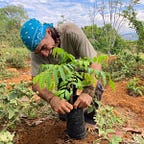Cultural Evolution as Biomimicry
Increasingly, people are looking to nature for inspiration about how to solve hard problems. This is usually called biomimicry and has to do with the study of living systems to see how nature has solved problems in the past that humans care about today.
[ — A great organization doing this kind of work is the Biomimicry Institute — ]
Unfortunately, most of the work on biomimicry has been based on a subtle confusion — one that treats the “human world” as separate and distinct from the rest of nature. We learn from nature because we are somehow presumed to be separate from it.
The truth is that humans are part of nature. Everything we do is therefore the creative expressions of a living system.
This profound truth is poised to greatly expand the meaning of biomimicry to include all of human culture, our technologies and modes of social organization, the solutions we have accumulated throughout our long history as a species.
I am a student of cultural evolution. This means I study human culture through the lens of the theories, frameworks, and methodologies of evolutionary biology. This collection of nearly 1000 books is all about cultural evolution.
When I look at human communities, I ask questions about the selection mechanisms that help some social features to spread while others fade away. I ponder the functional adaptations of human tools and behaviors in the context of their environments — both social and ecological. And I treat everything humans do as continuous with and growing out of the larger web of life on Earth with its 3.8 billion year history.
Most of the work on biomimicry to date has been focused on product design. Want to build strong fabrics for clothing materials? Study the fibers of a spider web. Want to create an energy-efficient building? Have a look at the heat transfer of a termite mound. Want to manage your organization better? Study how ant colonies achieve massive cooperation with chemical signals.
Notice how each of these examples treats humans as the beneficiary of intelligence gathered from nature. But what if we learn from HUMANS AS NATURE to apply nature’s intelligence to our relationships with the rest of the Earth? This is what becomes possible when we study cultural evolution as a kind of biomimicry.
Consider this: Humans form social niches. This means our ancestors evolved specialized abilities for survival and flourishing in environmental conditions made in large part by our social environments. Language is a great demonstrator for this point — humans grow up, form our identities, and become functioning adults in contexts of shared words, concepts, and semantic relationships.
How does this relate to our flourishing? For one thing, we “leap frog” our learnings by picking up complex knowledge through active teaching from people who are experts at things we need to learn. This accelerates the spread and adoption of solutions that have been proven to work in the past. Also we use gossip to manage relationships about who is trustworthy (and good to partner with) while avoiding those whom others tell us are unreliable or dishonest. This helps us form effective teams more quickly and efficiently to achieve difficult tasks through cooperation.
Similarly, when humans build technologies we create “support tools” that are used to produce functional pieces that are brought into the production process at the appropriate stage of manufacturing. These tools (and the organized knowledge about how to use them) enable us to step into a manageable piece of complex design processes to produce tools that no individual human could create on their own.
My point here is that these evolved cultural abilities ARE biomimicry. Study and apply them to the design of education systems, management of teams, crafting of stories, or the organization of communities and you are doing biomimicry work!
Now consider this big challenge — humanity needs to learn how to live sustainably with the Earth. Some historical cultures have lived with self-sufficiency in the same landscapes for hundreds or thousands of years. These cultures (the indigenous ones) have accumulated a collection of cultural adaptations to their local places that withstood the test of time. As such, if we learn how their cultures work and apply the knowledge with intention and purpose, we are doing biomimicry work.
All of a sudden the preservation of cultural heritage becomes a design necessity for cultural adaptation in changing landscapes! Everyone who is concerned about climate change today should take note. We have a body of knowledge about how human communities have adapted to their environments in the past. Apply this knowledge to help future communities find functional fitness to what their landscapes are becoming and you are doing a whole new level of biomimicry work.
This is what my collaborators are doing with the emerging network of regenerative projects around the world. We are managing the restoration of lands while growing resilient, healthy communities by applying the principles of living systems to guided, intentional social change. In other words, we are applying insights from cultural evolution to the regeneration of people, ecosystems, and ultimately the planet.
This is the scale and depth of biomimicry that the world needs today.
Onward, fellow humans.
Joe Brewer is the executive director of the Center for Applied Cultural Evolution. Get involved by signing up for our newsletter and consider making a donation to support our work.
